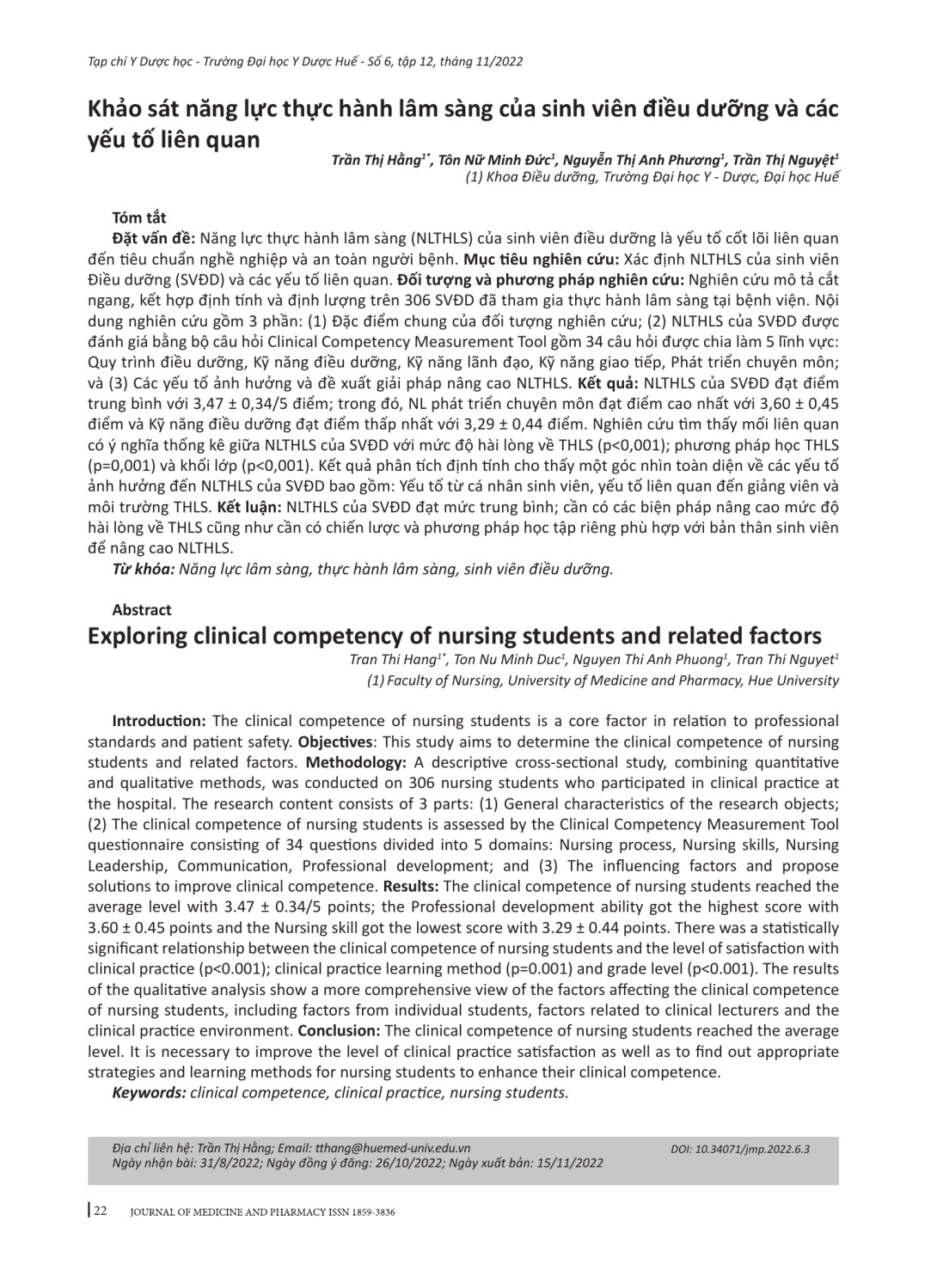
Xác định NLTHLS của sinh viên Điều dưỡng (SVĐD) và các yếu tố liên quan. Đối tượng và phương pháp nghiên cứu: Nghiên cứu mô tả cắt ngang, kết hợp định tính và định lượng trên 306 SVĐD đã tham gia thực hành lâm sàng tại bệnh viện. Nội dung nghiên cứu gồm 3 phần: (1) Đặc điểm chung của đối tượng nghiên cứu; (2) NLTHLS của SVĐD được đánh giá bằng bộ câu hỏi Clinical Competency Measurement Tool gồm 34 câu hỏi được chia làm 5 lĩnh vực: Quy trình điều dưỡng, Kỹ năng điều dưỡng, Kỹ năng lãnh đạo, Kỹ năng giao tiếp, Phát triển chuyên môn; và (3) Các yếu tố ảnh hưởng và đề xuất giải pháp nâng cao NLTHLS. Kết quả: NLTHLS của SVĐD đạt điểm trung bình với 3,47 ± 0,34/5 điểm; trong đó, NL phát triển chuyên môn đạt điểm cao nhất với 3,60 ± 0,45 điểm và Kỹ năng điều dưỡng đạt điểm thấp nhất với 3,29 ± 0,44 điểm. Nghiên cứu tìm thấy mối liên quan có ý nghĩa thống kê giữa NLTHLS của SVĐD với mức độ hài lòng về THLS (p<0,001); phương pháp học THLS (p=0,001) và khối lớp (p<0,001). Kết quả phân tích định tính cho thấy một góc nhìn toàn diện về các yếu tố ảnh hưởng đến NLTHLS của SVĐD bao gồm: Yếu tố từ cá nhân sinh viên, yếu tố liên quan đến giảng viên và môi trường THLS. Kết luận: NLTHLS của SVĐD đạt mức trung bình; cần có các biện pháp nâng cao mức độ hài lòng về THLS cũng như cần có chiến lược và phương pháp học tập riêng phù hợp với bản thân sinh viên để nâng cao NLTHLS.
The clinical competence of nursing students is a core factor in relation to professional standards and patient safety. Objectives: This study aims to determine the clinical competence of nursing students and related factors. Methodology: A descriptive cross-sectional study, combining quantitative and qualitative methods, was conducted on 306 nursing students who participated in clinical practice at the hospital. The research content consists of 3 parts: (1) General characteristics of the research objects; (2) The clinical competence of nursing students is assessed by the Clinical Competency Measurement Tool questionnaire consisting of 34 questions divided into 5 domains: Nursing process, Nursing skills, Nursing Leadership, Communication, Professional development; and (3) The influencing factors and propose solutions to improve clinical competence. Results: The clinical competence of nursing students reached the average level with 3.47 ± 0.34/5 points; the Professional development ability got the highest score with 3.60 ± 0.45 points and the Nursing skill got the lowest score with 3.29 ± 0.44 points. There was a statistically significant relationship between the clinical competence of nursing students and the level of satisfaction with clinical practice (p<0.001); clinical practice learning method (p=0.001) and grade level (p<0.001). The results of the qualitative analysis show a more comprehensive view of the factors affecting the clinical competence of nursing students, including factors from individual students, factors related to clinical lecturers and the clinical practice environment. Conclusion: The clinical competence of nursing students reached the average level. It is necessary to improve the level of clinical practice satisfaction as well as to find out appropriate strategies and learning methods for nursing students to enhance their clinical competence.
- Đăng nhập để gửi ý kiến
